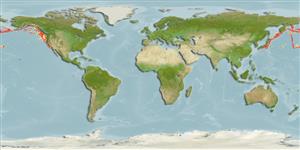Teleostei (teleosts) >
Gadiformes (Cods) >
Macrouridae (Grenadiers or rattails)
Etymology: Coryphaenoides: Greek, koryphaina = dolphin fish + Suffix oides = similar to (Ref. 45335).
More on author: Gilbert.
Environment: milieu / climate zone / depth range / distribution range
Ecology
Marine; bathydemersal; depth range 1285 - 2904 m (Ref. 10941). Deep-water; 66°N - 32°N
North Pacific: Sea of Okhotsk to Alaska and southern California, USA.
Size / Weight / Age
Maturity: Lm ? range ? - ? cm
Max length : 55.0 cm TL male/unsexed; (Ref. 6885)
Dorsal spines (total): 2; Anal spines: 0. 2nd spine of 1st dorsal fin very long and slender, terminating in a long filament, smooth near base but outer half strongly toothed; 1st dorsal with 12 to 14 soft rays, ray count of 2nd dorsal unknown; caudal fin very narrow; anal rays numerous, long and low; pectorals long and slender; outside rays of pelvic fins very long and filamentous (Ref. 6885). Dark brown in color; black on fins, nostrils, ventral surfaces of snout, lips and gill membranes (Ref. 6885). Branchiostegal rays: 6 (Ref. 36385).
Bathybenthic (Ref. 36385). Oviparous, with planktonic larvae (Ref. 36385).
Life cycle and mating behavior
Maturity | Reproduction | Spawning | Eggs | Fecundity | Larvae
Endo, H., D. Tsutsui and K. Amaoka, 1994. Range extensions of two deep-sea macrourids Coryphaenoides filifer and Squalogadus modificatus to the Sea of Okhotsk. Jap. J. Ichthyol. 41(3):330-333. (Ref. 10941)
IUCN Red List Status (Ref. 130435: Version 2024-2)
Threat to humans
Harmless
Human uses
Fisheries: of no interest
Tools
Special reports
Download XML
Internet sources
Estimates based on models
Preferred temperature (Ref.
123201): 1.9 - 2.5, mean 2.1 °C (based on 88 cells).
Phylogenetic diversity index (Ref.
82804): PD
50 = 0.5000 [Uniqueness, from 0.5 = low to 2.0 = high].
Bayesian length-weight: a=0.00214 (0.00109 - 0.00421), b=3.20 (3.03 - 3.37), in cm total length, based on LWR estimates for this (Sub)family-body shape (Ref.
93245).
Trophic level (Ref.
69278): 4.5 ±0.37 se; based on food items.
Resilience (Ref.
120179): Very Low, minimum population doubling time more than 14 years (Preliminary K or Fecundity.).
Fishing Vulnerability (Ref.
59153): Moderate vulnerability (42 of 100).
